Python实现动态柱状图的绘制
阳862 人气:0一.基础柱状图
如图
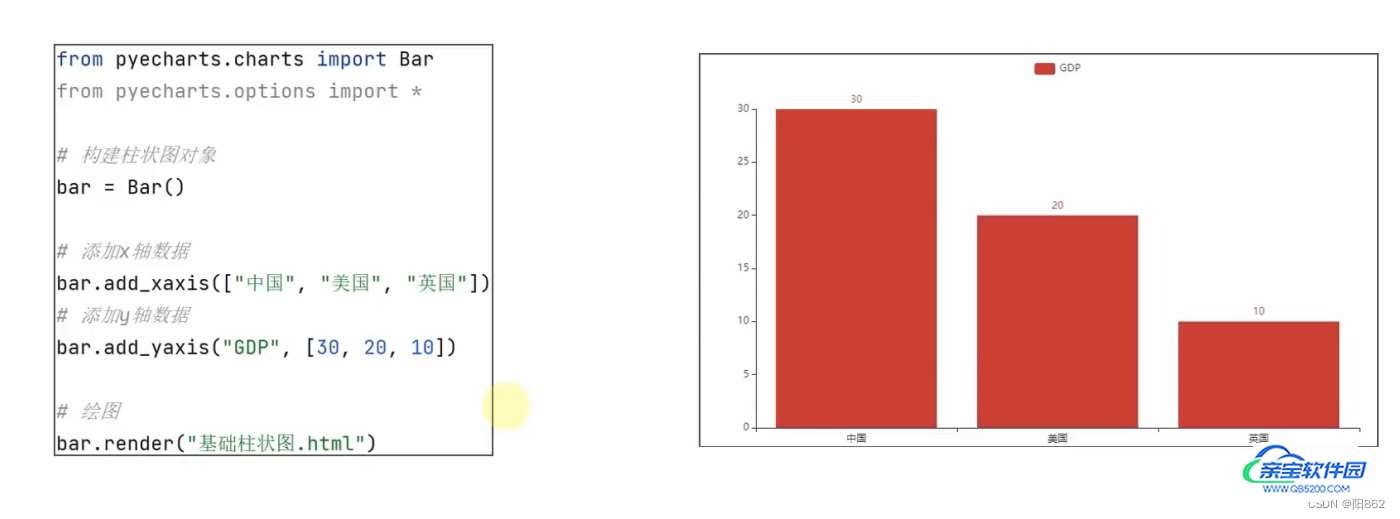
演示
from pyecharts.charts import Bar
from pyecharts.options import *
#构建柱状图对象
bar=Bar()
#添加x轴对象
bar.add_xaxis(["中国","美国","日本"])
#添加y轴对象
bar.add_yaxis("GDP",[40,50,30])
#设置全局选项
bar.set_global_opts(
title_opts=TitleOpts(title="GDP柱状图"),#加名称
visualmap_opts=VisualMapOpts(#加范围显示
is_show=True
)
)
#绘图
bar.render("基础柱状图.html")结果是
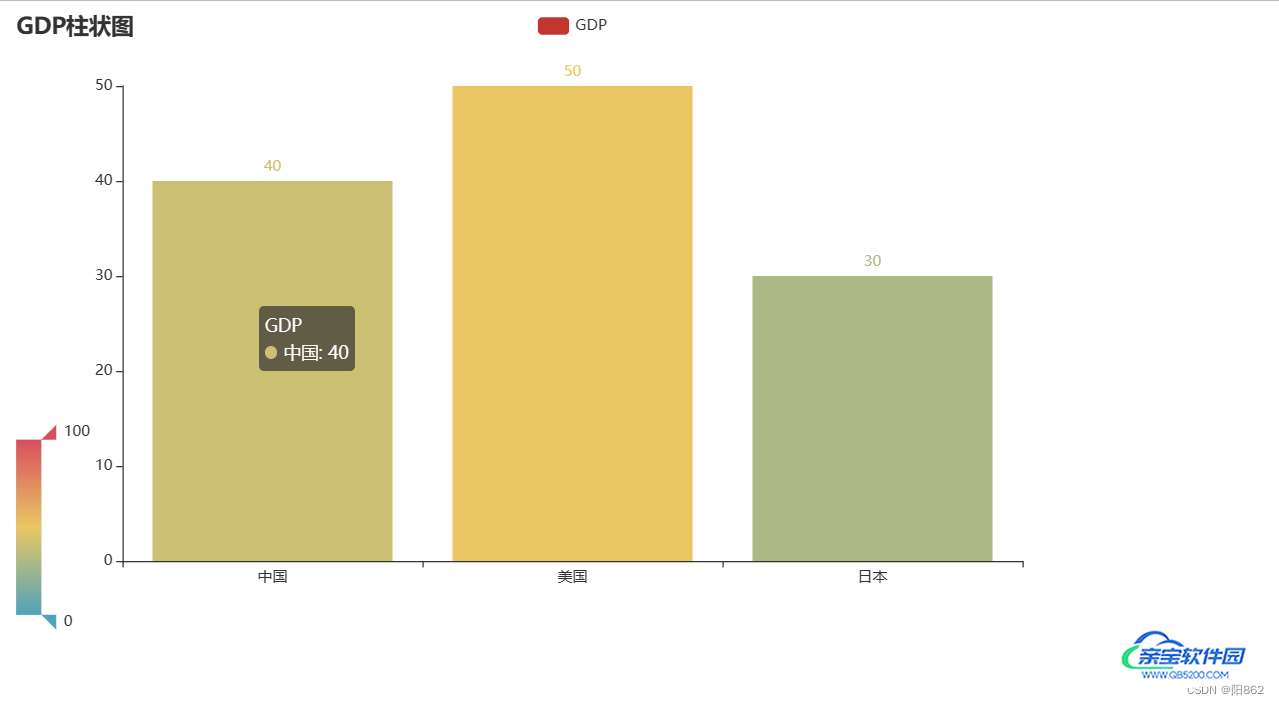

反转x轴,y轴,设置数值标签在右侧
#添加y轴对象
bar.add_yaxis("GDP",[40,50,30],label_opts=LabelOpts(position="right"))
#反转x轴y轴
bar.reversal_axis()结果是

小结
- 通过Bar()构建一个柱状图对象
- 和折线图一样,通过add_xaxis()和add_yaxis()添加x和y轴数据
- 通过柱状图对象的: reversal_axis(),反转x和y轴
- 通过label_opts=LabelOpts(position="right")设置数值标签在右侧显示
二.基础时间线柱状图
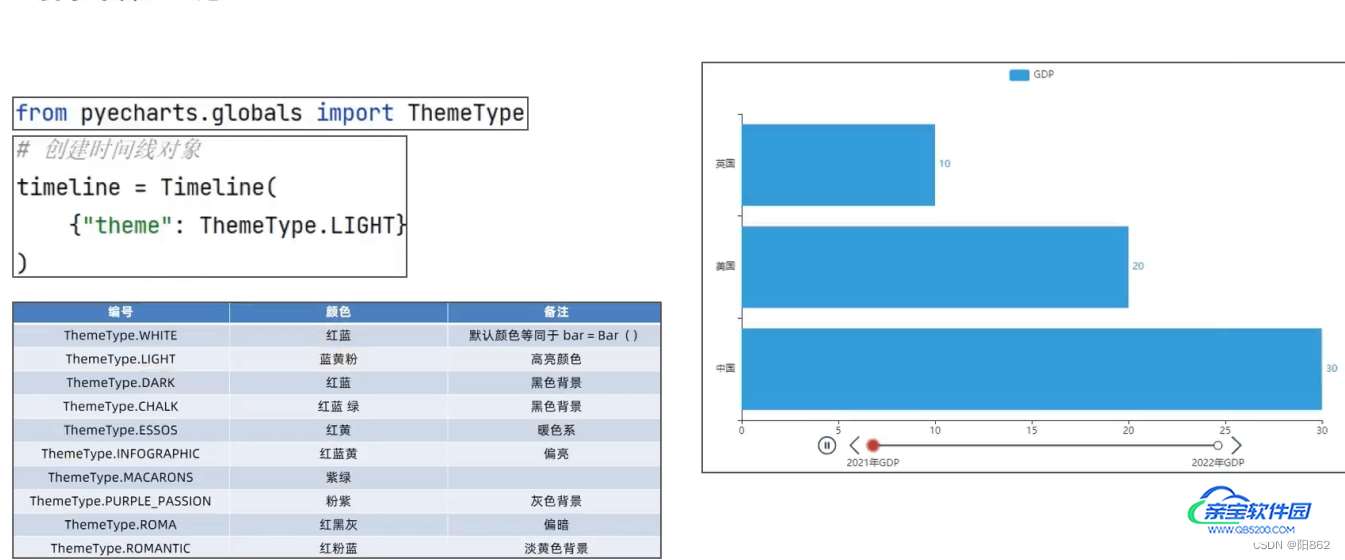
演示
from pyecharts.charts import Bar,Timeline
from pyecharts.options import *
from pyecharts.globals import ThemeType
#构建柱状图对象
bar1=Bar()
#添加x轴对象
bar1.add_xaxis(["中国","美国","日本"])
#添加y轴对象
bar1.add_yaxis("GDP",[40,50,30],label_opts=LabelOpts(position="right"))
#反转x轴y轴
bar1.reversal_axis()
#设置全局选项
bar1.set_global_opts(
title_opts=TitleOpts(title="GDP柱状图"),#加名称
visualmap_opts=VisualMapOpts(#加范围显示
is_show=True
)
)
#构建柱状图对象
bar2=Bar()
#添加x轴对象
bar2.add_xaxis(["中国","美国","日本"])
#添加y轴对象
bar2.add_yaxis("GDP",[50,60,45],label_opts=LabelOpts(position="right"))
#反转x轴y轴
bar2.reversal_axis()
#设置全局选项
bar2.set_global_opts(
title_opts=TitleOpts(title="GDP柱状图"),#加名称
visualmap_opts=VisualMapOpts(#加范围显示
is_show=True
)
)
#构建柱状图对象
bar3=Bar()
#添加x轴对象
bar3.add_xaxis(["中国","美国","日本"])
#添加y轴对象
bar3.add_yaxis("GDP",[60,65,40],label_opts=LabelOpts(position="right"))
#反转x轴y轴
bar3.reversal_axis()
#设置全局选项
bar3.set_global_opts(
title_opts=TitleOpts(title="GDP柱状图"),#加名称
visualmap_opts=VisualMapOpts(#加范围显示
is_show=True
)
)
#构建时间线对象
timeline=Timeline({"theme":ThemeType.LIGHT})
#在时间线上添加柱状图对象
timeline.add(bar1,"点1")
timeline.add(bar2,"点2")
timeline.add(bar3,"点3")
#绘图是用时间线对象绘图,而不是用 bar了
timeline.render("基础时间线柱状图.html")结果是
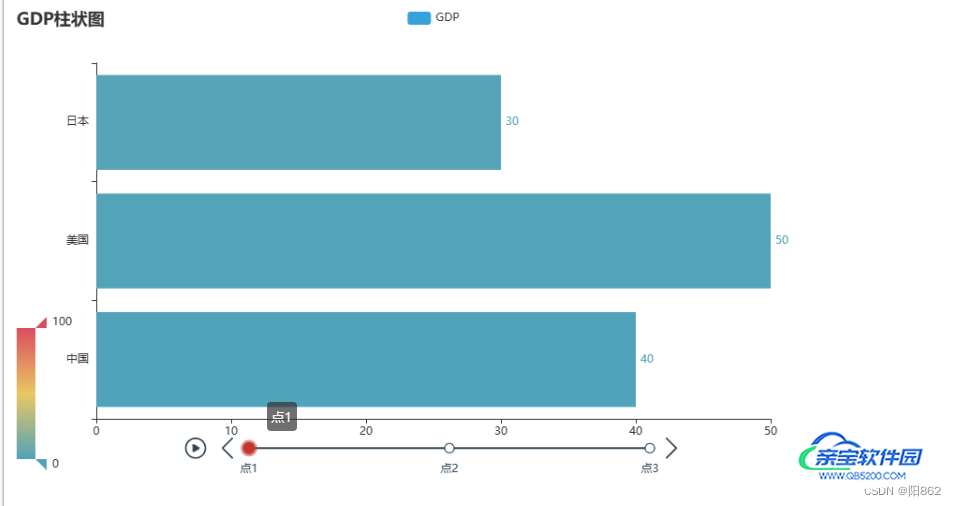
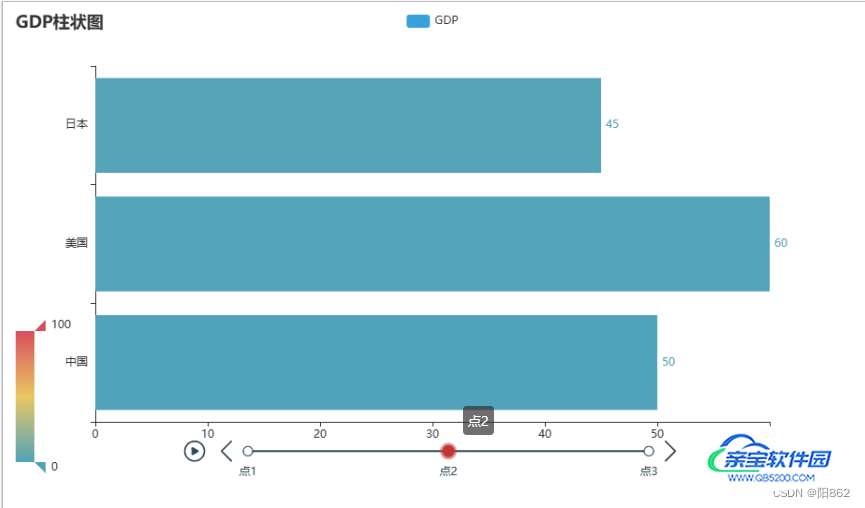

点击下面不同的点,就会显示出不同的柱状图
当然,这不是我们想要的最终结果,我们希望他可以制动播放并且一直循环下去
代码
#自动播放设置
timeline.add_schema(
play_interval=1000,#这里是放下一张图的时间间隔,毫秒为单位
is_timeline_show=True,#是否显示时间线
is_auto_play=True,#是否自动播放
is_loop_play=True#是否循环播放
)
#绘图是用时间线对象绘图,而不是用 bar了
timeline.render("基础时间线柱状图.html")结果是

这样我们就可以控制上图中的“播放键”去控制是否自动循环播放
三.GDP动态柱状图绘制
1.了解列表的sort方法并配合lambda匿名函数完成列表排序
在前面我们学习过sorted函数,可以对数据容器进行排序。
在后面的数据处理中,我们需要对列表进行排序,并指定排序规则,sorted函数就无法完成了。我们补充学习列表的sort方法。
使用方式:
列表.sort(key=选择排序依据的函数, reverse=TruelFalse)
- 参数key,是要求传入一个函数,表示将列表的每一个元素都传入函数中,返回排序的依据
- 参数reverse,是否反转排序结果,True表示降序,False表示升序
演示
my_list=[["a",12],["b",4],["c",45]]
def choose_sort_key(element):
return element[1]
my_list.sort(key=choose_sort_key,reverse=True)
print(my_list)
my_list.sort(key=lambda element:element[1],reverse=False)
print(my_list)结果是
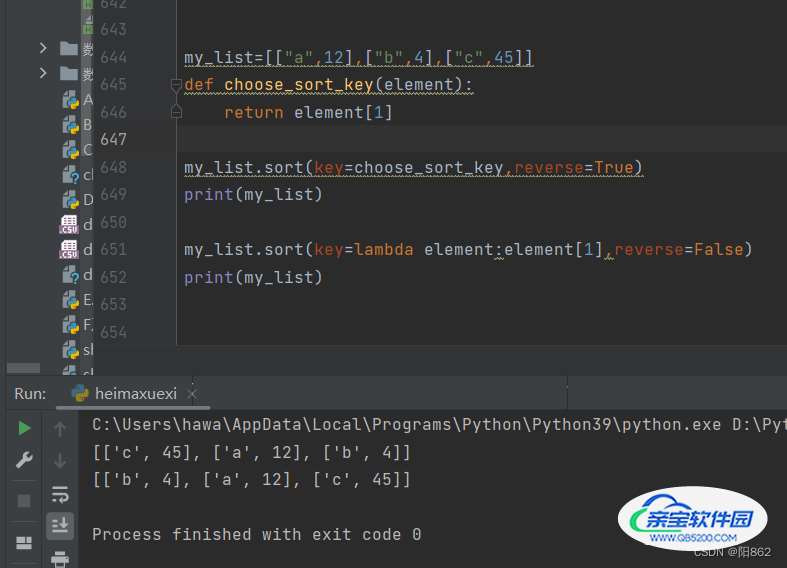
上图中,第一种是基于带名函数,第二种是基于lambda函数
2.完成图表所需数据
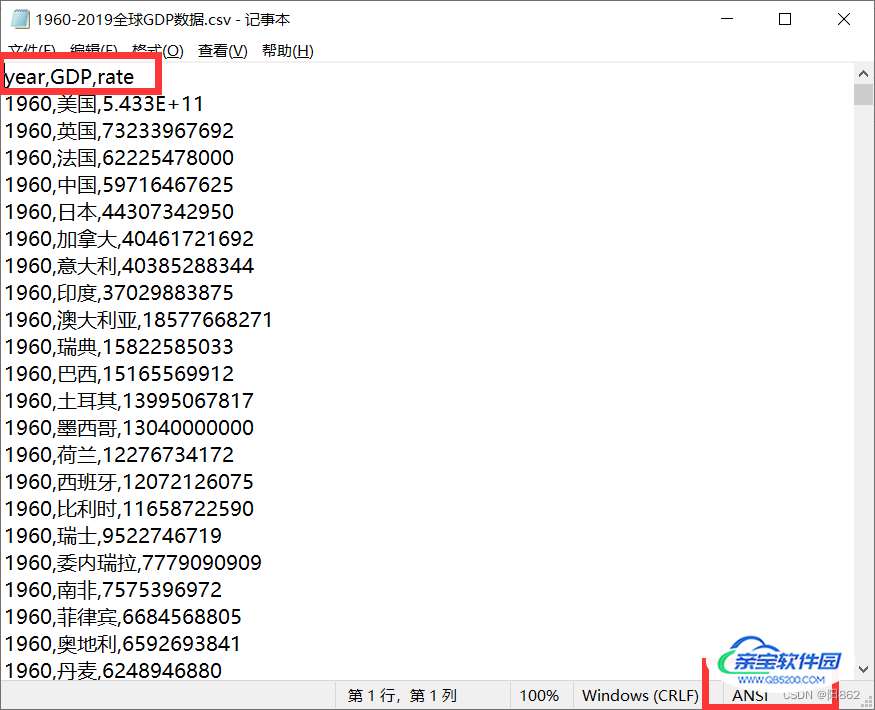

#将数据转为字典存储,格式为:
#{ 年份:[[国家, gdp],[国家, gdp],...... ],年份:[[国家,gdp],[国家, gdp],.....], ...... },比如:
#{ 1960:[[美国, 123],[中国, 231],...... ],1961:[[美国,124],[中国, 234],.....], ...... }
#先定义一个字典
data_dict={}
for line in data_lines:
year=int(line.split(",")[0])#年份
country=line.split(",")[1]#省份
GDP=float(line.split(",")[2])#因为美国的GDP是科学计数法,所以用float强制转回来
#如何判断字典里面有没有制定的key呢?
try:
data_dict[year].append([country,GDP])
except KeyError:
data_dict[year]=[]
data_dict[year].append([country,GDP])
print(data_dict)结果是
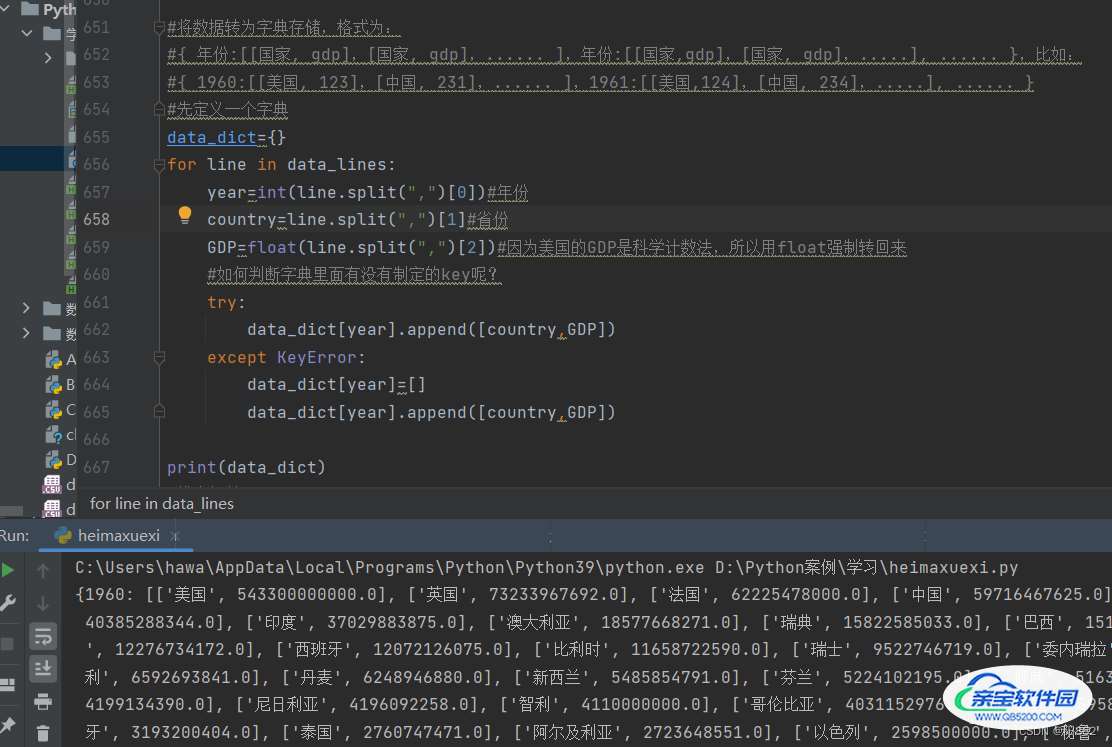
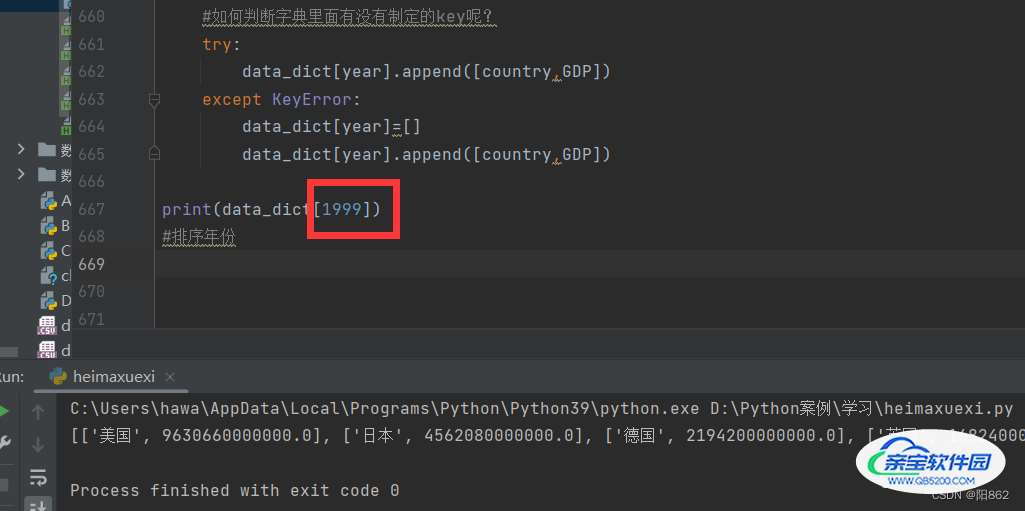
上图就是1999年的数据
3.完成GDP动态图表绘制

from pyecharts.charts import Bar,Timeline
from pyecharts.options import *
#读取文件
f=open("D:/1960-2019全球GDP数据.csv","r",encoding="ANSI")
data_lines=f.readlines()
#关闭文件
f.close()
#删除第一行数据
data_lines.pop(0)
#将数据转为字典存储,格式为:
#{ 年份:[[国家, gdp],[国家, gdp],...... ],年份:[[国家,gdp],[国家, gdp],.....], ...... },比如:
#{ 1960:[[美国, 123],[中国, 231],...... ],1961:[[美国,124],[中国, 234],.....], ...... }
#先定义一个字典
data_dict={}
for line in data_lines:
year=int(line.split(",")[0])#年份
country=line.split(",")[1]#省份
GDP=float(line.split(",")[2])#因为美国的GDP是科学计数法,所以用float强制转回来
#如何判断字典里面有没有制定的key呢?
try:
data_dict[year].append([country,GDP])
except KeyError:
data_dict[year]=[]
data_dict[year].append([country,GDP])
#排序年份
sorted_year_list=sorted(data_dict.keys())
timeline = Timeline()#创建时间线对象
for year in sorted_year_list:
data_dict[year].sort(key=lambda element:element[1],reverse=True)
#取出本年份前八名的国家
year_data=data_dict[year][:8]
x_data=[]
y_data=[]
for country_gdp in year_data:
x_data.append(country_gdp[0])#x轴添加国家
y_data.append(country_gdp[1]/100000000)#y轴添加GDP数据,单位为亿元
#构建柱状图
bar=Bar()
bar.add_xaxis(x_data)
bar.add_yaxis("GDP亿元",y_data,label_opts=LabelOpts(position="right"))
#反转x轴,y轴
bar.reversal_axis()
#创建时间线对象
timeline.add(bar,str(year))
#设置时间为自动播放
timeline.add_schema(
play_interval=1000,#时间间隔
is_timeline_show=True,#是否显示时间
is_loop_play=True,#是否循环
is_auto_play=True#是否自动播放
)
#绘图
timeline.render("1960——2019全球GDP前八国家.html")结果是
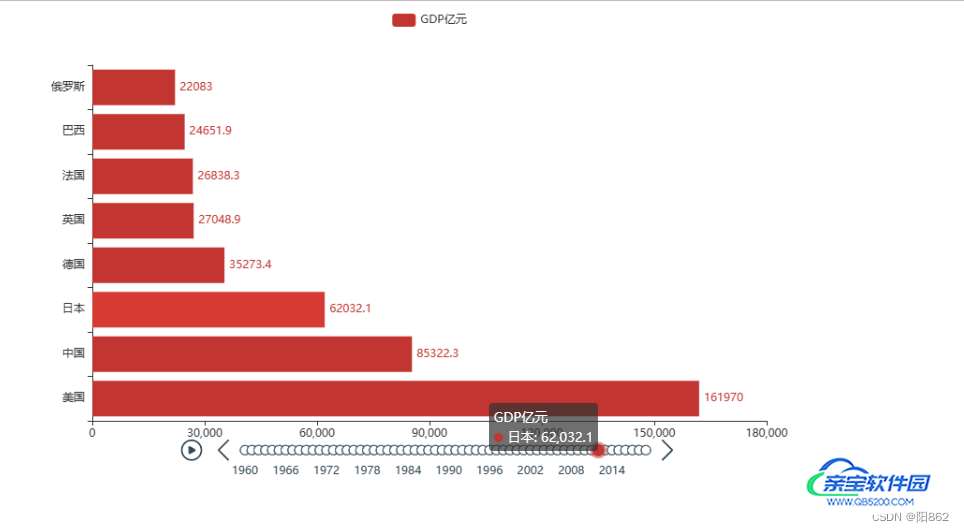
存在问题:我们希望第一行是GDP数量最多的,然后依次递减
解决方法很简单:把x轴和y轴上的数据都反转一下就可以了
#构建柱状图
bar=Bar()
x_data.reverse()
y_data.reverse()
bar.add_xaxis(x_data)
bar.add_yaxis("GDP亿元",y_data,label_opts=LabelOpts(position="right"))结果是

这样就基本没问题了
我们还可以给他:
添加主题类型
from pyecharts.globals import ThemeType
timeline = Timeline({"theme":ThemeType.LIGHT})#创建时间线对象结果是

设置动态标题
#反转x轴,y轴
bar.reversal_axis()
#设置每一年的图表标题
bar.set_global_opts(
title_opts=TitleOpts(title=f"{year}年全球GDP前八数据")
)结果是
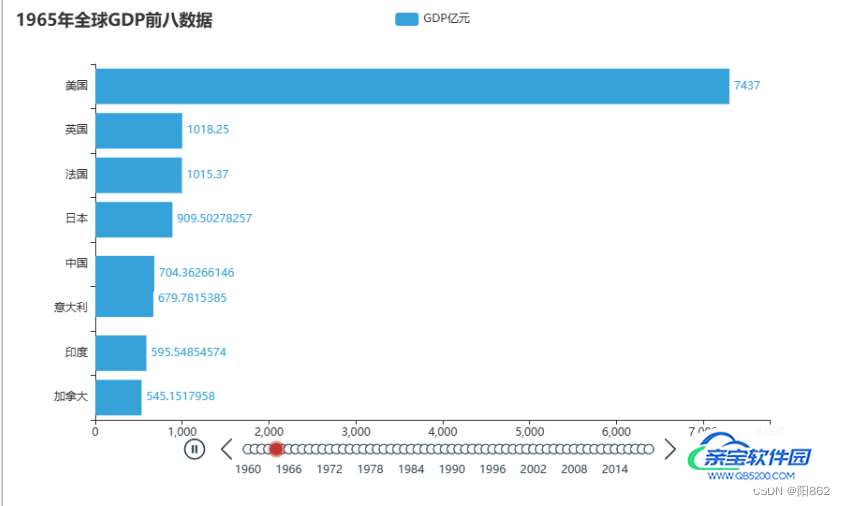
四.完整代码
from pyecharts.charts import Bar,Timeline
from pyecharts.options import *
from pyecharts.globals import ThemeType
#读取文件
f=open("D:/1960-2019全球GDP数据.csv","r",encoding="ANSI")
data_lines=f.readlines()
#关闭文件
f.close()
#删除第一行数据
data_lines.pop(0)
#将数据转为字典存储,格式为:
#{ 年份:[[国家, gdp],[国家, gdp],...... ],年份:[[国家,gdp],[国家, gdp],.....], ...... },比如:
#{ 1960:[[美国, 123],[中国, 231],...... ],1961:[[美国,124],[中国, 234],.....], ...... }
#先定义一个字典
data_dict={}
for line in data_lines:
year=int(line.split(",")[0])#年份
country=line.split(",")[1]#省份
GDP=float(line.split(",")[2])#因为美国的GDP是科学计数法,所以用float强制转回来
#如何判断字典里面有没有制定的key呢?
try:
data_dict[year].append([country,GDP])
except KeyError:
data_dict[year]=[]
data_dict[year].append([country,GDP])
#排序年份
sorted_year_list=sorted(data_dict.keys())
timeline = Timeline({"theme":ThemeType.LIGHT})#创建时间线对象
for year in sorted_year_list:
data_dict[year].sort(key=lambda element:element[1],reverse=True)
#取出本年份前八名的国家
year_data=data_dict[year][:8]
x_data=[]
y_data=[]
for country_gdp in year_data:
x_data.append(country_gdp[0])#x轴添加国家
y_data.append(country_gdp[1]/100000000)#y轴添加GDP数据,单位为亿元
#构建柱状图
bar=Bar()
x_data.reverse()
y_data.reverse()
bar.add_xaxis(x_data)
bar.add_yaxis("GDP亿元",y_data,label_opts=LabelOpts(position="right"))
#反转x轴,y轴
bar.reversal_axis()
#设置每一年的图表标题
bar.set_global_opts(
title_opts=TitleOpts(title=f"{year}年全球GDP前八数据")
)
#创建时间线对象
timeline.add(bar,str(year))
#设置时间为自动播放
timeline.add_schema(
play_interval=1000,#时间间隔
is_timeline_show=True,#是否显示时间
is_loop_play=True,#是否循环
is_auto_play=True#是否自动播放
)
#绘图
timeline.render("1960——2019全球GDP前八国家.html")加载全部内容